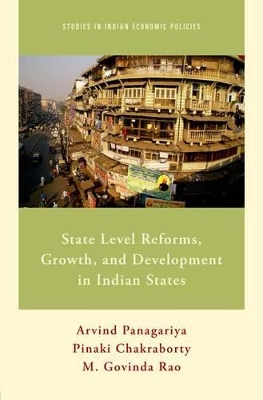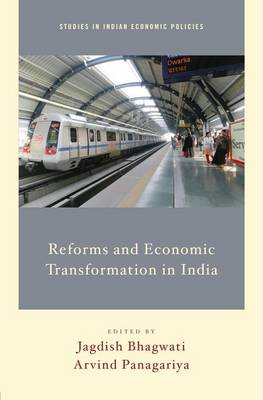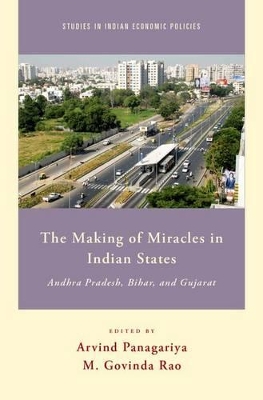Studies in Indian Economic Policies
3 total works
State Level Reforms, Growth, and Development in Indian States
by Arvind Panagariya, Pinaki Chakraborty, and M. Govinda Rao
Published 1 May 2014
Most discussions of India's substantive economic growth since the 1990s tend to focus on national level statistics or on particular sectors such as the financial and call service sectors or on the pharmaceutical industry. But with a population of 1.2 billion, India demands to be treated like a collection of individual "countries, " rather than a unified nation. Ten of its states have populations equaling or exceeding that of the United Kingdom. If the state of Uttar Pradesh were a country, it would be the fourth largest, behind China, India, and the United States. These facts pointedly tell us that if we are to understand the ongoing experiment in economic reforms and poverty alleviation, we must study India at the level of the state.
In this spirit, State Level Reforms and Growth and Development in Indian States provides the first-ever comprehensive analysis of growth at the highly diverse state level. The authors argue that when the national government loosened its stronghold on industry and services, state governments were able to shape the fortunes of their citizens through state-level policy reforms. Because of this, every Indian state experienced accelerated growth, unlike China during the first two decades of its development when the eastern half flourished as the western half lagged. Every Indian state has grown faster in the last decade than any other decade in the post-independence era. In fact, some of the poorest states, notably Bihar and Orissa, have been growing the fastest.
Professors Panagariya and Chakraborty and Dr. Rao refute the common assumptions that growth has not occurred or that poverty has not been reduced in all Indian states. The recent reforms have also led to improved access in every state to basic amenities such as permanent houses, electricity, water, and sanitation. These accomplishments notwithstanding, regional inequality on a per capita basis has grown as well. Reforms in state-controlled sectors such as agriculture, industry, healthcare, and education have not advanced as far as some analysts previously predicted. The authors outline the reforms in these areas and draw on the experience of states that have successfully carried out some of them. The authors pay special attention to reforms in the areas of education and health while recognizing that the Indian constitution vests in the states much of this legislative and other authority and while considering the real absolute rise in income, literacy, and health status across all the states.
In this spirit, State Level Reforms and Growth and Development in Indian States provides the first-ever comprehensive analysis of growth at the highly diverse state level. The authors argue that when the national government loosened its stronghold on industry and services, state governments were able to shape the fortunes of their citizens through state-level policy reforms. Because of this, every Indian state experienced accelerated growth, unlike China during the first two decades of its development when the eastern half flourished as the western half lagged. Every Indian state has grown faster in the last decade than any other decade in the post-independence era. In fact, some of the poorest states, notably Bihar and Orissa, have been growing the fastest.
Professors Panagariya and Chakraborty and Dr. Rao refute the common assumptions that growth has not occurred or that poverty has not been reduced in all Indian states. The recent reforms have also led to improved access in every state to basic amenities such as permanent houses, electricity, water, and sanitation. These accomplishments notwithstanding, regional inequality on a per capita basis has grown as well. Reforms in state-controlled sectors such as agriculture, industry, healthcare, and education have not advanced as far as some analysts previously predicted. The authors outline the reforms in these areas and draw on the experience of states that have successfully carried out some of them. The authors pay special attention to reforms in the areas of education and health while recognizing that the Indian constitution vests in the states much of this legislative and other authority and while considering the real absolute rise in income, literacy, and health status across all the states.
Reforms and Economic Transformation in India
by Jagdish Bhagwati and Arvind Panagariya
Published 2 November 2012
Reforms and Economic Transformation in India is the second volume in the series Studies in Indian Economic Policies. The first volume, India's Reforms: How They Produced Inclusive Growth (OUP, 2012), systematically demonstrated that reforms-led growth in India led to reduced poverty among all social groups. They also led to shifts in attitudes whereby citizens overwhelmingly acknowledge the benefits that accelerated growth has brought them and as voters, they now reward the governments that deliver superior economic outcomes and punish those that fail to do so.
This latest volume takes as its starting point the fact that while reforms have undoubtedly delivered in terms of poverty reduction and associated social objectives, the impact has not been as substantial as seen in other reform-oriented economies such as South Korea and Taiwan in the 1960s and 1970s, and more recently, in China. The overarching hypothesis of the volume is that the smaller reduction in poverty has been the result of slower transformation of the economy from a primarily agrarian to a modern, industrial one. Even as the GDP share of agriculture has seen rapid decline, its employment share has declined very gradually. More than half of the workforce in India still remains in agriculture. In addition, non-farm workers are overwhelmingly in the informal sector. Against this background, the nine original essays by eminent economists pursue three broad themes using firm level data in both industry and services.
The papers in part I ask why the transformation in India has been slow in terms of the movement of workers out of agriculture, into industry and services, and from informal to formal employment. They address what India needs to do to speed up this transformation. They specifically show that severe labor-market distortions and policy bias against large firms has been a key factor behind the slow transformation. The papers in part II analyze the transformation that reforms have brought about within and across enterprises. For example, they investigate the impact of privatization on enterprise profitability. Part III addresses the manner in which the reforms have helped promote social transformation. Here the papers analyze the impact the reforms have had on the fortunes of the socially disadvantaged groups in terms of wage and education outcomes and as entrepreneurs.
This latest volume takes as its starting point the fact that while reforms have undoubtedly delivered in terms of poverty reduction and associated social objectives, the impact has not been as substantial as seen in other reform-oriented economies such as South Korea and Taiwan in the 1960s and 1970s, and more recently, in China. The overarching hypothesis of the volume is that the smaller reduction in poverty has been the result of slower transformation of the economy from a primarily agrarian to a modern, industrial one. Even as the GDP share of agriculture has seen rapid decline, its employment share has declined very gradually. More than half of the workforce in India still remains in agriculture. In addition, non-farm workers are overwhelmingly in the informal sector. Against this background, the nine original essays by eminent economists pursue three broad themes using firm level data in both industry and services.
The papers in part I ask why the transformation in India has been slow in terms of the movement of workers out of agriculture, into industry and services, and from informal to formal employment. They address what India needs to do to speed up this transformation. They specifically show that severe labor-market distortions and policy bias against large firms has been a key factor behind the slow transformation. The papers in part II analyze the transformation that reforms have brought about within and across enterprises. For example, they investigate the impact of privatization on enterprise profitability. Part III addresses the manner in which the reforms have helped promote social transformation. Here the papers analyze the impact the reforms have had on the fortunes of the socially disadvantaged groups in terms of wage and education outcomes and as entrepreneurs.
Growth miracles typically have been studied at the country level. The Making of Miracles in Indian States breaks from that tradition and studies three growth miracles in India at the level of the state: Andhra Pradesh, Bihar, and Gujarat. These are three of the largest and most diverse states in India. Andhra Pradesh is situated in the south of India, Bihar in the east, and Gujarat in the west. Bihar is the poorest among all states in India, Gujarat the third richest among the largest eighteen states, and Andhra Pradesh in the middle. Andhra Pradesh and Gujarat have long coastal lines while Bihar is landlocked. Yet, all of these states have grown at rates exceeding 8% for an entire decade in the 21st century.
Despite many differences in the initial conditions, several common threads tie the high-growth experiences of the three states. First, accelerated growth has permitted acceleration in the growth of development expenditures in all three states, which has helped improve connectivity to markets. Alongside this growth, poverty has seen accelerated decline. Second, the composition of growth matters. Growth in high-value commodities such as fruits and vegetables, commercial crops, dairy, and animal husbandry in Andhra Pradesh and Gujarat has led to accelerated reduction in rural poverty. However, the failure of labor-intensive industry has stunted the migration of workers out of agriculture into industry. Third, the quality of leadership that brings improved governance with it is central to improved outcomes in the states. Visionary leaders---Chandrababu Naidu in Andhra Pradesh, Nitish Kumar in Bihar, and Narendra Modi in Gujarat---played critical roles in the making of all three miracles. Fourth, the three studies also bring out the importance of pro-market reforms and the adoption of technology in development. Finally, the studies show that good economics is also good politics: voters reward the chief ministers who bring about significant improvement to the people's lives.
Despite many differences in the initial conditions, several common threads tie the high-growth experiences of the three states. First, accelerated growth has permitted acceleration in the growth of development expenditures in all three states, which has helped improve connectivity to markets. Alongside this growth, poverty has seen accelerated decline. Second, the composition of growth matters. Growth in high-value commodities such as fruits and vegetables, commercial crops, dairy, and animal husbandry in Andhra Pradesh and Gujarat has led to accelerated reduction in rural poverty. However, the failure of labor-intensive industry has stunted the migration of workers out of agriculture into industry. Third, the quality of leadership that brings improved governance with it is central to improved outcomes in the states. Visionary leaders---Chandrababu Naidu in Andhra Pradesh, Nitish Kumar in Bihar, and Narendra Modi in Gujarat---played critical roles in the making of all three miracles. Fourth, the three studies also bring out the importance of pro-market reforms and the adoption of technology in development. Finally, the studies show that good economics is also good politics: voters reward the chief ministers who bring about significant improvement to the people's lives.


